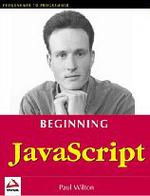

Дата отгрузки на данный момент неизвестна.
Товар закончился у основного поставщика, и, после получения заказа от вас, мы закажем его у других поставщиков. Мы не можем гарантировать выполнение данного заказа, поэтому настоятельно не рекомендуем заказывать данный товар, используя предоплату (банковский перевод и т.п.). Заказ на такой товар действителен в течение 3 недель (если в течение 3 недель товар не придет, заказ будет отменен). Однако, это не означает, что товар нельзя заказать вновь, поскольку в некоторых случаях возможны и более поздние поставки.
Технические характеристики
uitable for learning basic programming for Web browsers, Beginning JavaScript is a patient, introductory tutorial on writing scripts successfully. It teaches you how to create client-side scripts (including full coverage of fundamentals like variables and flow control, plus plenty of screen shots.)
JavaScript is a good way to learn programming. Its powerful, of course, but the book takes small steps, using scripts that work with string and time data first, and then moving to manipulating browser objects like forms and windows. A running case study for a trivia game helps anchor the steps with a practical (and fun) example. There are plenty of tips on debugging your scripts (including how to use the Microsoft Script Debugger tool), and each section includes sample questions. (The book also offers extensive answers in over 80 pages at the end of the book.)
Theres plenty of material on the differences between Internet Explorer and Netscape, especially when it comes to Dynamic HTML (DHTML). Coverage of the Document Object Model (DOM) for browsers helps bring the text up to date on some of the latest standards in Web browsers (including the new Netscape 6).
While the focus of Beginning JavaScript clearly is on the client, later sections turn to server-side ASP development (in which the sample trivia game is enhanced with ASPs written in JavaScript using ADO and Microsoft Access.) Reference sections on JavaScript and the browser object model for Internet Explorer and Netscape (through version 4.x) round out the material.
In all, with its approachable style and clearly rendered code examples, Beginning JavaScript makes for a worthwhile first book of programming for todays browsers. Even if you havent programmed before, this text can give you the tools you need to bring your static Web pages to life. --Richard Dragan
Topics covered:
Introduction to JavaScript
Cross-browser compatibility issues
JavaScript data types and variables
Displaying errors
Calculations
Operators
String handling
Flow control statements
Loops
Introduction to using objects
The browser object model
HTML forms (including types of input controls)
Frames and windows
Tutorial for regular expressions
Advanced string methods
Date, time, and timer objects
Common errors
The Microsoft Script Debugger
Cookies
Dynamic HTML (DHTML) on Internet Explorer 4.0 and Netscape Navigator 4.x
The Document Object Model (DOM)
ActiveX controls and plug-ins used with JavaScript
Server-scripting
Introduction to ASP and databases (including SQL basics and database design with Microsoft Access)
Sample case study for a trivia game
Sample exercises and answers
References to JavaScript
Internet Explorer 4 and 5 and Netscape Navigator 4 objects
ASP object model reference